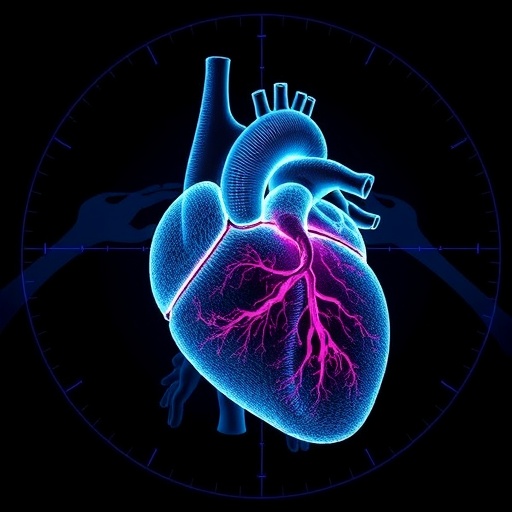
In the delicate world of neonatal intensive care, the cardiovascular health of newborns often presents some of the most intricate and challenging puzzles for clinicians. Among the myriad of conditions faced, hypertrophic cardiomyopathy in infants of diabetic mothers (IDM), cardiovascular imbalance in twin-to-twin transfusion syndrome (TTTS), and cardiopulmonary complications associated with bronchopulmonary dysplasia (BPD) stand out for their complex and nuanced hemodynamic profiles. As advances in neonatal medicine push the boundaries of survival, the imperative for precision in the hemodynamic assessment and management of these vulnerable infants becomes ever more pressing. This emerging frontier demands not only refined diagnostic tools but also a sophisticated understanding of the unique cardiovascular physiology in the perinatal period.
Cardiomyopathy in infants of diabetic mothers epitomizes the intricate cardiac remodeling provoked by maternal metabolic derangements. IDM frequently manifest hypertrophic cardiomyopathy, where pathological thickening of the ventricular myocardium disrupts normal systolic and diastolic function. This hypertrophy creates a precarious hemodynamic environment, potentiating low cardiac output and precipitating pulmonary hypertension (PH). The heterogeneity observed in IDM cardiac presentation underscores the necessity for individualized evaluation. Beyond conventional echocardiography, advanced imaging modalities that quantify myocardial strain and relaxation dynamics are vital to unraveling the subtle variations in myocardial performance and guiding nuanced therapeutic plans. Such precision in measurement facilitates proactive intervention aimed at averting clinical decompensation.
Twin-to-twin transfusion syndrome introduces another layer of hemodynamic complexity, marked by unbalanced intraplacental vascular anastomoses leading to disproportionate blood volume distribution between fetuses. The resultant hemodynamic stress most dramatically burdens the recipient twin, precipitating volume overload, altered preload and afterload conditions, and subsequent cardiac strain. The pathophysiological cascade includes elevated ventricular wall tension, potential heart failure, and systemic endothelial dysfunction. Serial transthoracic neonatal echocardiography (TNE) emerges as a cornerstone in the continuous monitoring of these dynamic changes, providing critical data to inform timing and selection of therapeutic interventions such as fetoscopic laser ablation or postnatal medical management. Here, the precision lies in deciphering evolving loading conditions to intercept and modulate maladaptive cardiovascular responses.
Bronchopulmonary dysplasia, a chronic lung disease often seen in premature infants, further complicates the neonatal cardiovascular landscape. In BPD, the interplay of pulmonary vascular remodeling and systemic arterial stiffness sets a complex stage where left ventricular (LV) dysfunction becomes intertwined with respiratory pathology. The resultant systemic hypertension and increased afterload impose an extra burden on the immature myocardium, exacerbating ventricular compromise and fostering a vicious cycle of cardiopulmonary deterioration. Hemodynamic monitoring techniques that dissect both systemic and pulmonary vascular dynamics with granular detail allow clinicians to tailor interventions targeting afterload reduction and right ventricular support. This integrated approach optimizes oxygen delivery and pulmonary function, underscoring the critical role of precision hemodynamics in the management of BPD-associated cardiac dysfunction.
Despite technological advancements, significant knowledge gaps endure in the realm of neonatal hemodynamics. The neonatal period is characterized by rapid physiological transitions, non-linear adaptations, and a delicate balance between systemic and pulmonary circulations. These complexities challenge the development of standardized protocols for assessment and interpretation of hemodynamic data. The heterogeneity of responses in various pathologies, coupled with immature organ systems, necessitates sophisticated analytical frameworks to accurately characterize cardiac function and vascular interactions. This calls for interdisciplinary collaboration integrating cardiology, neonatology, and biomedical engineering to refine monitoring methodologies that can capture temporal hemodynamic shifts with high fidelity.
Equally pressing is the quest to elucidate the long-term cardiovascular sequelae of neonatal hemodynamic disturbances in conditions like IDM, TTTS, and BPD. Emerging evidence suggests that early-life cardiovascular insults may predispose survivors to arrhythmias, hypertension, and heart failure in later years, yet precise mechanistic pathways remain elusive. Rigorous longitudinal studies employing advanced imaging, biomarker profiling, and genetic analysis are vital to map trajectories from neonatal cardiovascular compromise to adult morbidity. This knowledge would inform targeted interventions during the critical window of developmental plasticity, with potential to alter disease course and improve life-long cardiovascular health.
The integration of novel biomarkers and predictive modeling represents a promising frontier in neonatal hemodynamic care. Biomarkers reflective of myocardial stress, inflammation, and vascular remodeling could enable early detection of adverse hemodynamic events before clinical deterioration. When combined with machine learning approaches utilizing multimodal patient data, predictive models may enhance risk stratification and personalized management plans. This precision medicine paradigm aspires to convert complex datasets into actionable insights, streamlining clinical decision-making and optimizing resource allocation in neonatal intensive care units.
Central to this evolving landscape is the refinement of neonatal echocardiographic techniques. The ability to non-invasively quantify myocardial strain, ventricular compliance, and pulmonary vascular resistance with greater sensitivity has revolutionized bedside cardiovascular assessment. Advanced Doppler modalities and speckle-tracking echocardiography have become indispensable tools in deciphering neonatal cardiac mechanics. Coupling these imaging advancements with real-time hemodynamic monitoring systems, including near-infrared spectroscopy and invasive pressure measurements, offers a comprehensive physiological portrait that supports precision-guided interventions.
Hemodynamic precision is not only a diagnostic aspiration but also profoundly influences therapeutic strategies. In IDM, for example, nuanced assessment guides pharmacologic interventions aimed at modulating myocardial contractility and preventing progression to heart failure. In TTTS, timing of in utero procedures hinges on detecting early signs of recipient twin cardiac strain. For BPD infants, titration of afterload-reducing agents demands precise delineation of systemic vascular stiffness and LV performance. These tailored therapies underscore a shift from one-size-fits-all approaches to individualized treatment paradigms grounded in detailed physiological understanding.
The challenges inherent to neonatal hemodynamic management also spotlight the need for innovation in device technology. Miniaturized sensors capable of continuous cardiovascular monitoring with minimal invasiveness could revolutionize care delivery. The development of wearable or implantable biosensors that provide uninterrupted hemodynamic data streams would enhance early detection of instability and enable timely therapeutic modulation. Moreover, advancements in telemedicine and data integration platforms may extend specialist expertise to resource-limited settings, democratizing access to high-precision neonatal cardiovascular care.
Educational initiatives are equally pivotal in translating research advances into clinical practice. Training healthcare providers to interpret complex hemodynamic data and integrate them into clinical reasoning is essential. Simulation-based education and interdisciplinary workshops can enhance competency in utilizing advanced diagnostic tools and implementing physiology-based interventions. Empowering neonatal care teams with these skills will foster consistent application of precision hemodynamics and improve patient outcomes across diverse care environments.
Financial and infrastructural considerations must also be addressed to realize the full potential of hemodynamic precision in neonatal care. Investment in cutting-edge diagnostic equipment, data analytics platforms, and personnel training requires strategic allocation of healthcare resources. Policymakers and healthcare leaders should recognize that enhanced neonatal cardiac care yields downstream benefits, reducing morbidity, hospital readmissions, and long-term healthcare costs. Advocacy and public awareness initiatives highlighting the importance of this domain could spur funding and support for ongoing research and clinical implementation.
Looking toward the future, the convergence of genomics, proteomics, and metabolomics with hemodynamic evaluation promises a holistic approach to neonatal cardiovascular health. Integrative “omics” data may unravel molecular signatures underlying individual hemodynamic phenotypes, enabling truly personalized therapy. Combining these insights with artificial intelligence-driven analytics could accelerate discovery of novel therapeutic targets and refine prognostic models with unprecedented precision.
In summary, the quest for hemodynamic precision in neonatal care confronts some of the most formidable challenges in modern medicine. Infants with complex cardiovascular conditions such as hypertrophic cardiomyopathy in IDM, hemodynamic imbalance in TTTS, and ventricular dysfunction in BPD demand sophisticated, individualized assessment and intervention strategies. Progress in advanced imaging, biomarker identification, and predictive analytics is propelling the field toward a future where tailored therapies optimize cardiac function and improve survival and quality of life. This dynamic and evolving field exemplifies the intersection of technology, physiology, and compassionate care, underscoring the critical importance of ongoing research, innovation, and clinical vigilance in safeguarding the hearts of our most vulnerable patients.
—
Subject of Research: Precision hemodynamic assessment and targeted management of complex neonatal cardiovascular conditions
Article Title: Diagnostic and Therapeutic Precision in Cardiovascular Diseases in the Neonatal Intensive Care
Article References: Sehgal, A., Buckingham, M.R., Hyland, R.M. et al. Diagnostic and therapeutic precision in cardiovascular diseases in the neonatal intensive care. J Perinatol (2025). https://doi.org/10.1038/s41372-025-02317-x
Image Credits: AI Generated
DOI: https://doi.org/10.1038/s41372-025-02317-x
Tags: advanced imaging techniques in cardiologycardiopulmonary issues in bronchopulmonary dysplasiacardiovascular physiology in the perinatal perioddiabetic mothers and heart healthhemodynamic assessment in newbornshypertrophic cardiomyopathy in infantsindividualized evaluation of cardiac conditionsmanagement of complex neonatal heart conditionsneonatal heart diseaseneonatal intensive care challengesprecision diagnosis in neonatal cardiologytwin-to-twin transfusion syndrome complications





